Comprehensive Nursing Care Report: CKD Patient Management Strategies
VerifiedAdded on 2020/05/11
|23
|6459
|37
Report
AI Summary
This report presents a comprehensive nursing care analysis of a 66-year-old patient, Lucy, diagnosed with chronic kidney disease (CKD) stemming from diabetic neuropathy. The report delves into Lucy's medical history, including coronary artery disease, gout, and type 2 diabetes mellitus, alongside her reliance on hemodialysis. It explores the pathophysiology of CKD, emphasizing the impact of diabetic neuropathy and the complications arising from her treatments, such as graft failure and cryptococcal meningitis. The report outlines the medications prescribed, including aspirin, calcitriol, and insulin, and justifies the rationale behind the case, highlighting the importance of early intervention. A significant portion of the report focuses on the diagnosis, treatment methods, and generation of a daily activities log to optimize nursing care. The report further addresses the management of CKD, reflecting on the outcomes of nursing care and suggesting alternative strategies. The analysis underscores the challenges of managing co-morbidities and the importance of tailored care plans to improve the patient's quality of life.
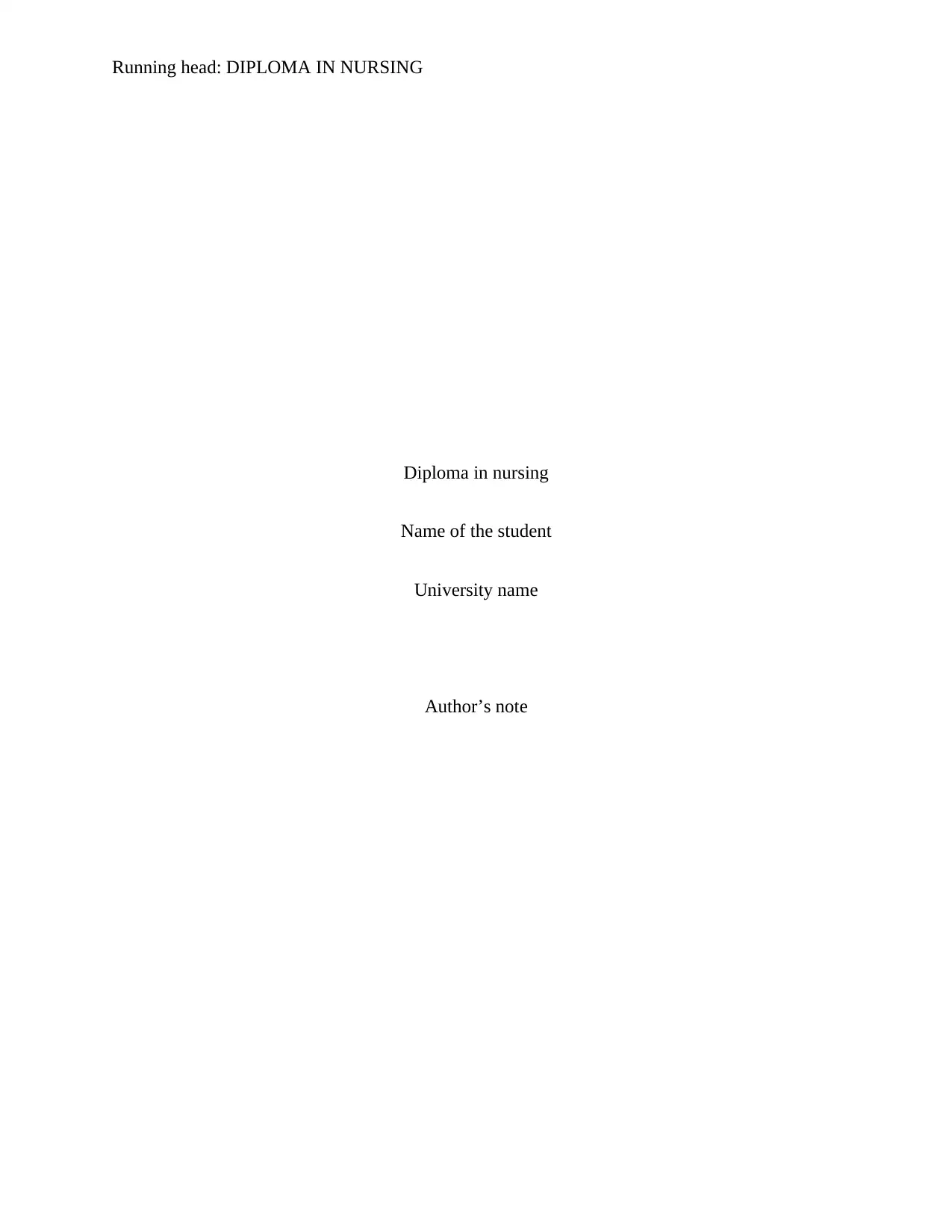
Running head: DIPLOMA IN NURSING
Diploma in nursing
Name of the student
University name
Author’s note
Diploma in nursing
Name of the student
University name
Author’s note
Paraphrase This Document
Need a fresh take? Get an instant paraphrase of this document with our AI Paraphraser
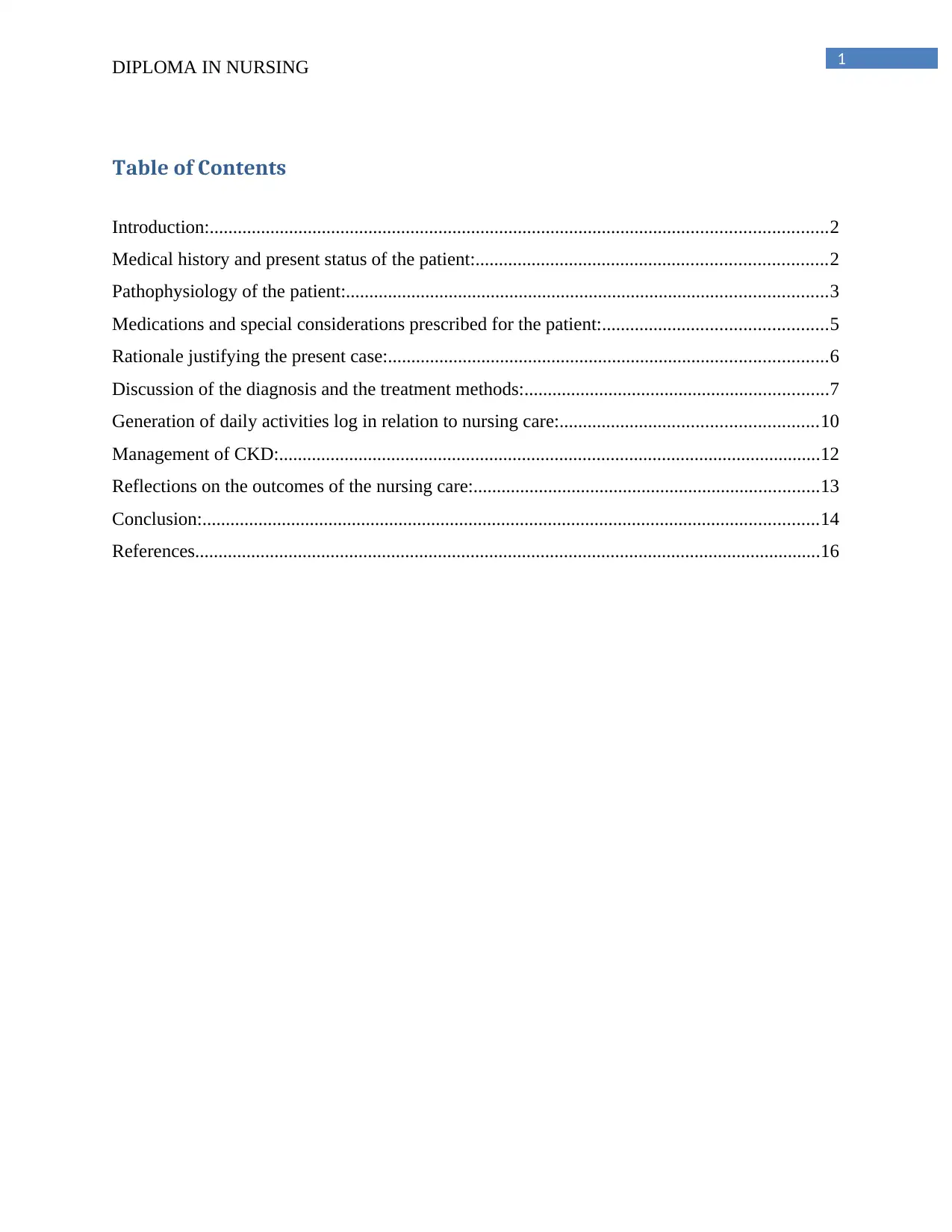
1DIPLOMA IN NURSING
Table of Contents
Introduction:....................................................................................................................................2
Medical history and present status of the patient:...........................................................................2
Pathophysiology of the patient:.......................................................................................................3
Medications and special considerations prescribed for the patient:................................................5
Rationale justifying the present case:..............................................................................................6
Discussion of the diagnosis and the treatment methods:.................................................................7
Generation of daily activities log in relation to nursing care:.......................................................10
Management of CKD:....................................................................................................................12
Reflections on the outcomes of the nursing care:..........................................................................13
Conclusion:....................................................................................................................................14
References......................................................................................................................................16
Table of Contents
Introduction:....................................................................................................................................2
Medical history and present status of the patient:...........................................................................2
Pathophysiology of the patient:.......................................................................................................3
Medications and special considerations prescribed for the patient:................................................5
Rationale justifying the present case:..............................................................................................6
Discussion of the diagnosis and the treatment methods:.................................................................7
Generation of daily activities log in relation to nursing care:.......................................................10
Management of CKD:....................................................................................................................12
Reflections on the outcomes of the nursing care:..........................................................................13
Conclusion:....................................................................................................................................14
References......................................................................................................................................16
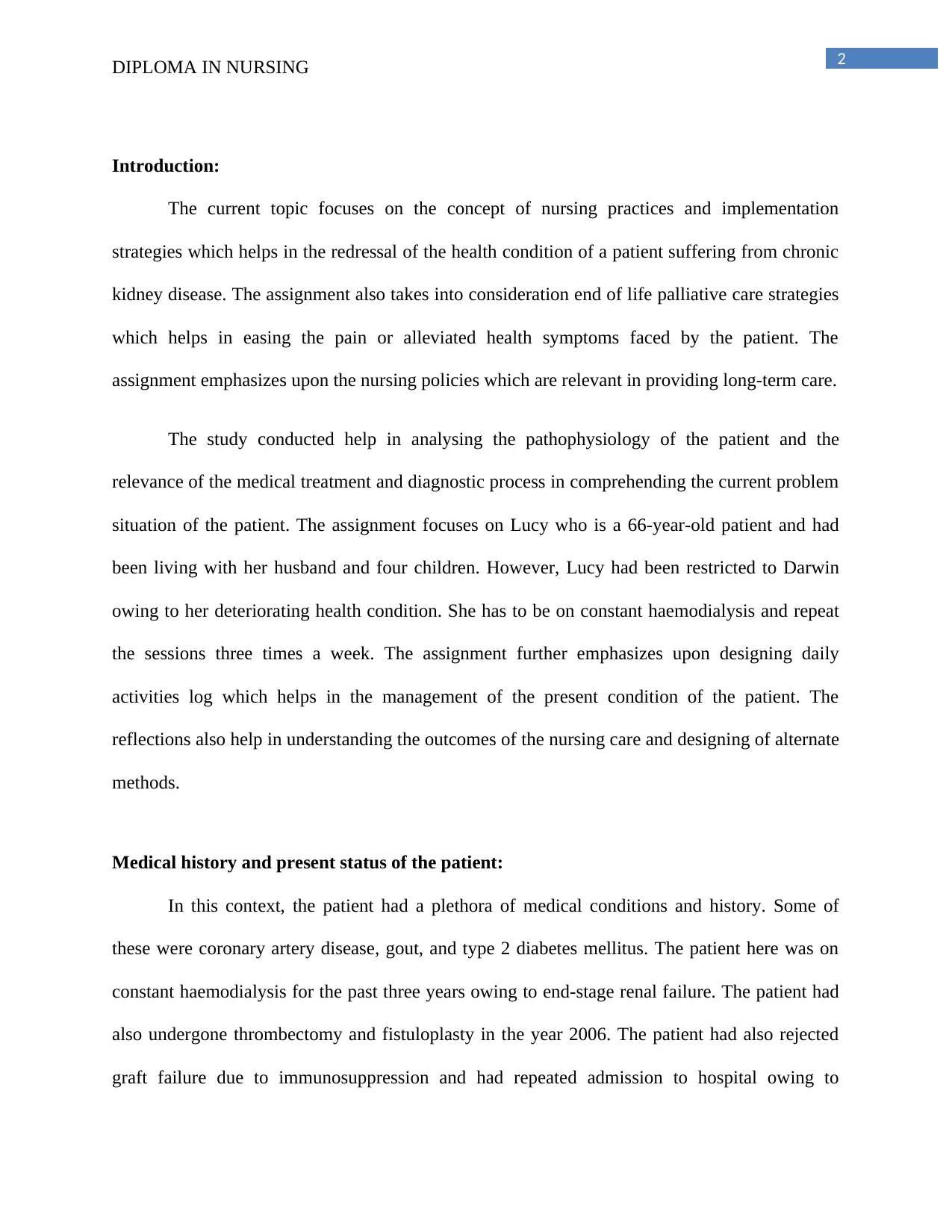
2DIPLOMA IN NURSING
Introduction:
The current topic focuses on the concept of nursing practices and implementation
strategies which helps in the redressal of the health condition of a patient suffering from chronic
kidney disease. The assignment also takes into consideration end of life palliative care strategies
which helps in easing the pain or alleviated health symptoms faced by the patient. The
assignment emphasizes upon the nursing policies which are relevant in providing long-term care.
The study conducted help in analysing the pathophysiology of the patient and the
relevance of the medical treatment and diagnostic process in comprehending the current problem
situation of the patient. The assignment focuses on Lucy who is a 66-year-old patient and had
been living with her husband and four children. However, Lucy had been restricted to Darwin
owing to her deteriorating health condition. She has to be on constant haemodialysis and repeat
the sessions three times a week. The assignment further emphasizes upon designing daily
activities log which helps in the management of the present condition of the patient. The
reflections also help in understanding the outcomes of the nursing care and designing of alternate
methods.
Medical history and present status of the patient:
In this context, the patient had a plethora of medical conditions and history. Some of
these were coronary artery disease, gout, and type 2 diabetes mellitus. The patient here was on
constant haemodialysis for the past three years owing to end-stage renal failure. The patient had
also undergone thrombectomy and fistuloplasty in the year 2006. The patient had also rejected
graft failure due to immunosuppression and had repeated admission to hospital owing to
Introduction:
The current topic focuses on the concept of nursing practices and implementation
strategies which helps in the redressal of the health condition of a patient suffering from chronic
kidney disease. The assignment also takes into consideration end of life palliative care strategies
which helps in easing the pain or alleviated health symptoms faced by the patient. The
assignment emphasizes upon the nursing policies which are relevant in providing long-term care.
The study conducted help in analysing the pathophysiology of the patient and the
relevance of the medical treatment and diagnostic process in comprehending the current problem
situation of the patient. The assignment focuses on Lucy who is a 66-year-old patient and had
been living with her husband and four children. However, Lucy had been restricted to Darwin
owing to her deteriorating health condition. She has to be on constant haemodialysis and repeat
the sessions three times a week. The assignment further emphasizes upon designing daily
activities log which helps in the management of the present condition of the patient. The
reflections also help in understanding the outcomes of the nursing care and designing of alternate
methods.
Medical history and present status of the patient:
In this context, the patient had a plethora of medical conditions and history. Some of
these were coronary artery disease, gout, and type 2 diabetes mellitus. The patient here was on
constant haemodialysis for the past three years owing to end-stage renal failure. The patient had
also undergone thrombectomy and fistuloplasty in the year 2006. The patient had also rejected
graft failure due to immunosuppression and had repeated admission to hospital owing to
⊘ This is a preview!⊘
Do you want full access?
Subscribe today to unlock all pages.

Trusted by 1+ million students worldwide

3DIPLOMA IN NURSING
cryptococcal meningitis. Additionally the past medical condition of the patient required for
collaboration from a number of medical channels. Therefore, the only measure which could be
undertaken for controlling the progression of the CKD in the patients was to put the patient on
haemodialysis. In the present context, Lucy had been admitted to the hospital owing to infection
caused by Cryptococcus group of bacteria. The microbial agent had been seen to cause
opportunistic infections in solid organ transplants. Lucy had been admitted to the hospital with
the relapse of the infection every time. Though, the rate of the infections could be controlled by
calcineurin-inhibitor immunosuppressive agents.
However, the incidences of relapse are often associated with immune reconstitution
inflammatory syndrome. Lucy also had a past history of haematoma which could be attributed to
relapse of microbial infection caused by the formation of a right brachiobasilic fistula. Therefore,
the only avenue left to Lucy over here was undertaking regular heamodyalysis. However, for
conducting dialysis the openings or the fistula needs to be created through which the purification
of the blood is channelized. This could become the site of new infections by permitting the entry
of microbes.
Pathophysiology of the patient:
The patient Lucy had been suffering from end-stage renal disease owing to diabetic
neuropathy. Therefore, the patient had to be on haemodialysis three times a week which limited
her travelling to the countryside to meet her children. The patient had been suffering from end-
stage renal disease also called Chronic Kidney Disease (CKD). At this stage, the kidneys fail to
meet the sufficient filtering requirements of the body. The loss of the filtering capabilities leads
to accumulation of harmful and toxic waste substances in the body of the patient. There are ways
cryptococcal meningitis. Additionally the past medical condition of the patient required for
collaboration from a number of medical channels. Therefore, the only measure which could be
undertaken for controlling the progression of the CKD in the patients was to put the patient on
haemodialysis. In the present context, Lucy had been admitted to the hospital owing to infection
caused by Cryptococcus group of bacteria. The microbial agent had been seen to cause
opportunistic infections in solid organ transplants. Lucy had been admitted to the hospital with
the relapse of the infection every time. Though, the rate of the infections could be controlled by
calcineurin-inhibitor immunosuppressive agents.
However, the incidences of relapse are often associated with immune reconstitution
inflammatory syndrome. Lucy also had a past history of haematoma which could be attributed to
relapse of microbial infection caused by the formation of a right brachiobasilic fistula. Therefore,
the only avenue left to Lucy over here was undertaking regular heamodyalysis. However, for
conducting dialysis the openings or the fistula needs to be created through which the purification
of the blood is channelized. This could become the site of new infections by permitting the entry
of microbes.
Pathophysiology of the patient:
The patient Lucy had been suffering from end-stage renal disease owing to diabetic
neuropathy. Therefore, the patient had to be on haemodialysis three times a week which limited
her travelling to the countryside to meet her children. The patient had been suffering from end-
stage renal disease also called Chronic Kidney Disease (CKD). At this stage, the kidneys fail to
meet the sufficient filtering requirements of the body. The loss of the filtering capabilities leads
to accumulation of harmful and toxic waste substances in the body of the patient. There are ways
Paraphrase This Document
Need a fresh take? Get an instant paraphrase of this document with our AI Paraphraser
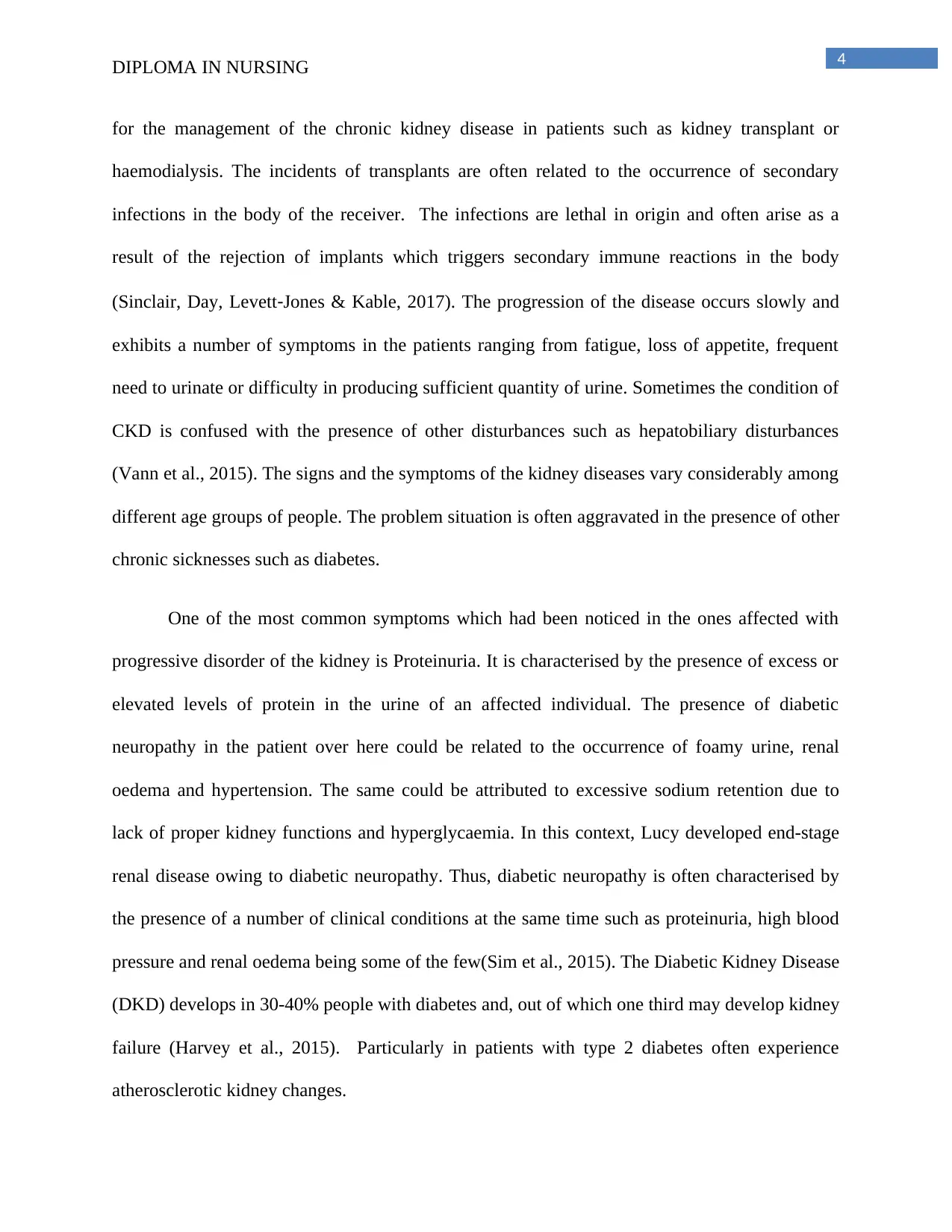
4DIPLOMA IN NURSING
for the management of the chronic kidney disease in patients such as kidney transplant or
haemodialysis. The incidents of transplants are often related to the occurrence of secondary
infections in the body of the receiver. The infections are lethal in origin and often arise as a
result of the rejection of implants which triggers secondary immune reactions in the body
(Sinclair, Day, Levett‐Jones & Kable, 2017). The progression of the disease occurs slowly and
exhibits a number of symptoms in the patients ranging from fatigue, loss of appetite, frequent
need to urinate or difficulty in producing sufficient quantity of urine. Sometimes the condition of
CKD is confused with the presence of other disturbances such as hepatobiliary disturbances
(Vann et al., 2015). The signs and the symptoms of the kidney diseases vary considerably among
different age groups of people. The problem situation is often aggravated in the presence of other
chronic sicknesses such as diabetes.
One of the most common symptoms which had been noticed in the ones affected with
progressive disorder of the kidney is Proteinuria. It is characterised by the presence of excess or
elevated levels of protein in the urine of an affected individual. The presence of diabetic
neuropathy in the patient over here could be related to the occurrence of foamy urine, renal
oedema and hypertension. The same could be attributed to excessive sodium retention due to
lack of proper kidney functions and hyperglycaemia. In this context, Lucy developed end-stage
renal disease owing to diabetic neuropathy. Thus, diabetic neuropathy is often characterised by
the presence of a number of clinical conditions at the same time such as proteinuria, high blood
pressure and renal oedema being some of the few(Sim et al., 2015). The Diabetic Kidney Disease
(DKD) develops in 30-40% people with diabetes and, out of which one third may develop kidney
failure (Harvey et al., 2015). Particularly in patients with type 2 diabetes often experience
atherosclerotic kidney changes.
for the management of the chronic kidney disease in patients such as kidney transplant or
haemodialysis. The incidents of transplants are often related to the occurrence of secondary
infections in the body of the receiver. The infections are lethal in origin and often arise as a
result of the rejection of implants which triggers secondary immune reactions in the body
(Sinclair, Day, Levett‐Jones & Kable, 2017). The progression of the disease occurs slowly and
exhibits a number of symptoms in the patients ranging from fatigue, loss of appetite, frequent
need to urinate or difficulty in producing sufficient quantity of urine. Sometimes the condition of
CKD is confused with the presence of other disturbances such as hepatobiliary disturbances
(Vann et al., 2015). The signs and the symptoms of the kidney diseases vary considerably among
different age groups of people. The problem situation is often aggravated in the presence of other
chronic sicknesses such as diabetes.
One of the most common symptoms which had been noticed in the ones affected with
progressive disorder of the kidney is Proteinuria. It is characterised by the presence of excess or
elevated levels of protein in the urine of an affected individual. The presence of diabetic
neuropathy in the patient over here could be related to the occurrence of foamy urine, renal
oedema and hypertension. The same could be attributed to excessive sodium retention due to
lack of proper kidney functions and hyperglycaemia. In this context, Lucy developed end-stage
renal disease owing to diabetic neuropathy. Thus, diabetic neuropathy is often characterised by
the presence of a number of clinical conditions at the same time such as proteinuria, high blood
pressure and renal oedema being some of the few(Sim et al., 2015). The Diabetic Kidney Disease
(DKD) develops in 30-40% people with diabetes and, out of which one third may develop kidney
failure (Harvey et al., 2015). Particularly in patients with type 2 diabetes often experience
atherosclerotic kidney changes.

5DIPLOMA IN NURSING
The presence of chronic kidney disease has often been related to other co-morbidities
such as cardiovascular disease as impaired ultrafiltration also affects the rate of circulation.
Additionally, decreased reabsorption of important nutrients from the fluids within the renal distal
convoluted tubules leads to a deficit of some of the important constituents such as calcitriol. The
less concentration of calcitriol further stimulates the synthesis of parathyroid hormones which
leads to increased absorption of calcium from the bones leading to osteoporosis or other bone-
related disorders. Additionally, the presence of co-morbidities such as diabetes further increases
the risk of progressive neuropathy in the patient manifold times (Sinclair et al., 2017).
Medications and special considerations prescribed for the patient:
Lucy had been suggested with a number of different medications for controlling the different co-
morbidities faced by the patient. Some of the medicines which had been suggested to the patient
are aspirin, Calcitriol, 1250 mg oral calcium tablets. Additionally, the patient was also given
folic acid for the restoring and maintaining the blood haemoglobin level. The patient was also
given omeprazole 20 mg oral daily along with daily doses of insulin. The aspirin was suggested
for the prevention of the development of cardiovascular disease in an individual. As asserted by
Hayes, Douglas & Bonner (2015), the presence of chronic kidney disease in an individual could
be related to the development of disease of the coronary arteries. This could be attributed to the
impaired blood ultrafiltration, which also affected the rate of blood circulation. Lucy had also
been substituted with high doses of Calcitriol as the decreased functioning of the proximal
tubules of the kidney lead to less absorption of calcitriol.
The reduction in the amount of calcitriol leads to stimulation of the parathyroid gland
leading to over secretion of para thyroxine. The para thyroxine selectively absorbs calcium from
The presence of chronic kidney disease has often been related to other co-morbidities
such as cardiovascular disease as impaired ultrafiltration also affects the rate of circulation.
Additionally, decreased reabsorption of important nutrients from the fluids within the renal distal
convoluted tubules leads to a deficit of some of the important constituents such as calcitriol. The
less concentration of calcitriol further stimulates the synthesis of parathyroid hormones which
leads to increased absorption of calcium from the bones leading to osteoporosis or other bone-
related disorders. Additionally, the presence of co-morbidities such as diabetes further increases
the risk of progressive neuropathy in the patient manifold times (Sinclair et al., 2017).
Medications and special considerations prescribed for the patient:
Lucy had been suggested with a number of different medications for controlling the different co-
morbidities faced by the patient. Some of the medicines which had been suggested to the patient
are aspirin, Calcitriol, 1250 mg oral calcium tablets. Additionally, the patient was also given
folic acid for the restoring and maintaining the blood haemoglobin level. The patient was also
given omeprazole 20 mg oral daily along with daily doses of insulin. The aspirin was suggested
for the prevention of the development of cardiovascular disease in an individual. As asserted by
Hayes, Douglas & Bonner (2015), the presence of chronic kidney disease in an individual could
be related to the development of disease of the coronary arteries. This could be attributed to the
impaired blood ultrafiltration, which also affected the rate of blood circulation. Lucy had also
been substituted with high doses of Calcitriol as the decreased functioning of the proximal
tubules of the kidney lead to less absorption of calcitriol.
The reduction in the amount of calcitriol leads to stimulation of the parathyroid gland
leading to over secretion of para thyroxine. The para thyroxine selectively absorbs calcium from
⊘ This is a preview!⊘
Do you want full access?
Subscribe today to unlock all pages.

Trusted by 1+ million students worldwide

6DIPLOMA IN NURSING
the bones to restore blood calcium level. This results in the weakening of bones leading to
conditions of osteoporosis in the patient. Therefore, Lucy had reportedly been showing
symptoms of gout which had made the activities of daily life difficult for her.
In this context, a number of medical tests were conducted for understanding the
pathophysiology of the patient. The normal creatinine is supposed to be within the range of 45-
90 μmol/L, whereas in the case of Lucy the creatinine was recorded at 486 μmol/L. The presence
of high amount of creatinine is evident of the fact the process of ultrafiltration does not occur
properly (Fried et al., 2013). Additionally, the haemoglobin per ml of the blood of the patient is
86 g/L which is much below the normal range of haemoglobin specified for a female that is 115-
165 ml. Though the sodium is present in an amount less than the normal concentration, the
calcium is within range. However, as argued by Zwar et al., (2017), the normal levels of calcium
could be due to the supplementary doses.
In this respect, some of the tests conducted such as the Hematocrit measures a number of
red blood cells present per ml of the blood. The clinical records of Lucy show that she has less
Haematocrit volume pointing towards the loss of blood in urine due to impaired ultrafiltration.
The friction and the TSAT tests were conducted to measure the amount of iron or haemoglobin
present in the blood of an individual. The iron concentration was relatively low pointing at
impaired ultrafiltration. The presence of high amount of urea and creatinine points at the low or
reduced glomerular filtration rate.
Rationale justifying the present case:
The present section focuses on the concept of chronic kidney disease which is a present
health debacle affecting people globally. The stressful lifestyle of people along with unhealthy
the bones to restore blood calcium level. This results in the weakening of bones leading to
conditions of osteoporosis in the patient. Therefore, Lucy had reportedly been showing
symptoms of gout which had made the activities of daily life difficult for her.
In this context, a number of medical tests were conducted for understanding the
pathophysiology of the patient. The normal creatinine is supposed to be within the range of 45-
90 μmol/L, whereas in the case of Lucy the creatinine was recorded at 486 μmol/L. The presence
of high amount of creatinine is evident of the fact the process of ultrafiltration does not occur
properly (Fried et al., 2013). Additionally, the haemoglobin per ml of the blood of the patient is
86 g/L which is much below the normal range of haemoglobin specified for a female that is 115-
165 ml. Though the sodium is present in an amount less than the normal concentration, the
calcium is within range. However, as argued by Zwar et al., (2017), the normal levels of calcium
could be due to the supplementary doses.
In this respect, some of the tests conducted such as the Hematocrit measures a number of
red blood cells present per ml of the blood. The clinical records of Lucy show that she has less
Haematocrit volume pointing towards the loss of blood in urine due to impaired ultrafiltration.
The friction and the TSAT tests were conducted to measure the amount of iron or haemoglobin
present in the blood of an individual. The iron concentration was relatively low pointing at
impaired ultrafiltration. The presence of high amount of urea and creatinine points at the low or
reduced glomerular filtration rate.
Rationale justifying the present case:
The present section focuses on the concept of chronic kidney disease which is a present
health debacle affecting people globally. The stressful lifestyle of people along with unhealthy
Paraphrase This Document
Need a fresh take? Get an instant paraphrase of this document with our AI Paraphraser
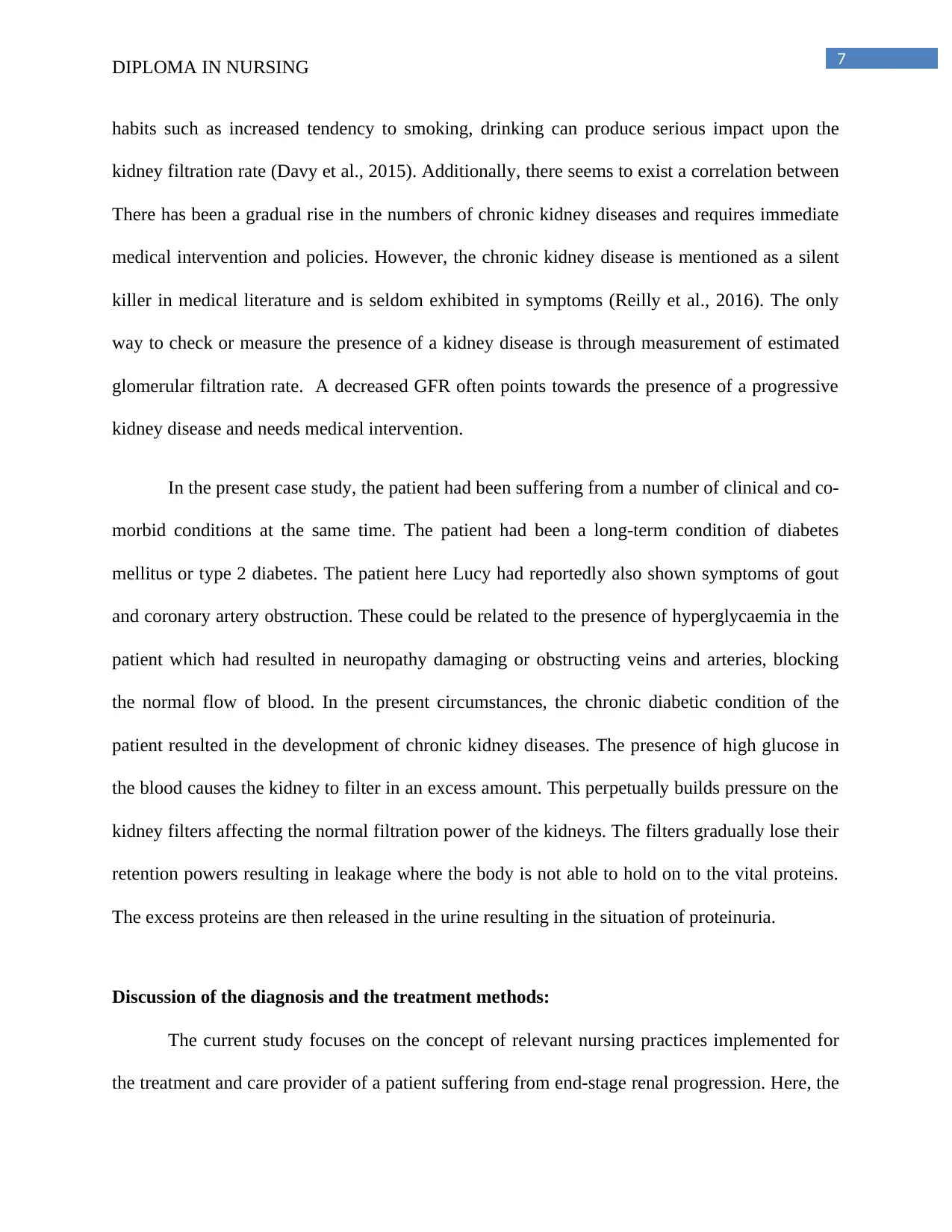
7DIPLOMA IN NURSING
habits such as increased tendency to smoking, drinking can produce serious impact upon the
kidney filtration rate (Davy et al., 2015). Additionally, there seems to exist a correlation between
There has been a gradual rise in the numbers of chronic kidney diseases and requires immediate
medical intervention and policies. However, the chronic kidney disease is mentioned as a silent
killer in medical literature and is seldom exhibited in symptoms (Reilly et al., 2016). The only
way to check or measure the presence of a kidney disease is through measurement of estimated
glomerular filtration rate. A decreased GFR often points towards the presence of a progressive
kidney disease and needs medical intervention.
In the present case study, the patient had been suffering from a number of clinical and co-
morbid conditions at the same time. The patient had been a long-term condition of diabetes
mellitus or type 2 diabetes. The patient here Lucy had reportedly also shown symptoms of gout
and coronary artery obstruction. These could be related to the presence of hyperglycaemia in the
patient which had resulted in neuropathy damaging or obstructing veins and arteries, blocking
the normal flow of blood. In the present circumstances, the chronic diabetic condition of the
patient resulted in the development of chronic kidney diseases. The presence of high glucose in
the blood causes the kidney to filter in an excess amount. This perpetually builds pressure on the
kidney filters affecting the normal filtration power of the kidneys. The filters gradually lose their
retention powers resulting in leakage where the body is not able to hold on to the vital proteins.
The excess proteins are then released in the urine resulting in the situation of proteinuria.
Discussion of the diagnosis and the treatment methods:
The current study focuses on the concept of relevant nursing practices implemented for
the treatment and care provider of a patient suffering from end-stage renal progression. Here, the
habits such as increased tendency to smoking, drinking can produce serious impact upon the
kidney filtration rate (Davy et al., 2015). Additionally, there seems to exist a correlation between
There has been a gradual rise in the numbers of chronic kidney diseases and requires immediate
medical intervention and policies. However, the chronic kidney disease is mentioned as a silent
killer in medical literature and is seldom exhibited in symptoms (Reilly et al., 2016). The only
way to check or measure the presence of a kidney disease is through measurement of estimated
glomerular filtration rate. A decreased GFR often points towards the presence of a progressive
kidney disease and needs medical intervention.
In the present case study, the patient had been suffering from a number of clinical and co-
morbid conditions at the same time. The patient had been a long-term condition of diabetes
mellitus or type 2 diabetes. The patient here Lucy had reportedly also shown symptoms of gout
and coronary artery obstruction. These could be related to the presence of hyperglycaemia in the
patient which had resulted in neuropathy damaging or obstructing veins and arteries, blocking
the normal flow of blood. In the present circumstances, the chronic diabetic condition of the
patient resulted in the development of chronic kidney diseases. The presence of high glucose in
the blood causes the kidney to filter in an excess amount. This perpetually builds pressure on the
kidney filters affecting the normal filtration power of the kidneys. The filters gradually lose their
retention powers resulting in leakage where the body is not able to hold on to the vital proteins.
The excess proteins are then released in the urine resulting in the situation of proteinuria.
Discussion of the diagnosis and the treatment methods:
The current study focuses on the concept of relevant nursing practices implemented for
the treatment and care provider of a patient suffering from end-stage renal progression. Here, the

8DIPLOMA IN NURSING
patient Lucy had been receiving haemodialysis three times a week and is also affected with a
number of co-morbidities. Some of the additional clinical ailments which had affected Lucy
include type 2 diabetes along with coronary artery disease and gout. The patient had also been
provided with grafts sessions which had resulted in severe immunosuppressant in the patient.
The patient had also developed cryptococcal meningitis which leads to recurrent hospital
administration of the patient. In this respect, one needs to mention that the presence of a number
of co-morbidities could lead to confusing result regarding the treatment and intervention plans
which need to be provided to the patient. The present medication routine followed with the
patient includes administration of high doses of aspirin for the prevention of future
cardiovascular diseases. However as argued by Thirsk, Moore, & Keyko (2014), the
incorporation of such high doses of aspirin could lead to corrosion of the walls of the stomach or
even lead to severe pain in case of overdose. The haemodialysis could be followed up with a
holistic care regimen. The implication of such methods helps in controlling high levels of
glucose in the blood of the patient.
Some of these activities include following a diet which is rich in minerals as impaired
ultrafiltration results in loss of the important nutrients from the blood of an individual. The
present health condition of the patient possesses a number of restrictions pertaining to the health
of the patient. Therefore, the support from the care professionals serves an important purpose.
However, some of the effective measures which could be implemented for controlling the
deterioration in the present health condition of the patient are monitoring the diet of the patient
strictly. Additionally, provision of supplements such as Calcitriol can also help in maintaining
the blood calcium level. However, the patient here had been provided with acid suppression
therapy by providing with 20mg of omeprazole daily. The consequences of which are debatable
patient Lucy had been receiving haemodialysis three times a week and is also affected with a
number of co-morbidities. Some of the additional clinical ailments which had affected Lucy
include type 2 diabetes along with coronary artery disease and gout. The patient had also been
provided with grafts sessions which had resulted in severe immunosuppressant in the patient.
The patient had also developed cryptococcal meningitis which leads to recurrent hospital
administration of the patient. In this respect, one needs to mention that the presence of a number
of co-morbidities could lead to confusing result regarding the treatment and intervention plans
which need to be provided to the patient. The present medication routine followed with the
patient includes administration of high doses of aspirin for the prevention of future
cardiovascular diseases. However as argued by Thirsk, Moore, & Keyko (2014), the
incorporation of such high doses of aspirin could lead to corrosion of the walls of the stomach or
even lead to severe pain in case of overdose. The haemodialysis could be followed up with a
holistic care regimen. The implication of such methods helps in controlling high levels of
glucose in the blood of the patient.
Some of these activities include following a diet which is rich in minerals as impaired
ultrafiltration results in loss of the important nutrients from the blood of an individual. The
present health condition of the patient possesses a number of restrictions pertaining to the health
of the patient. Therefore, the support from the care professionals serves an important purpose.
However, some of the effective measures which could be implemented for controlling the
deterioration in the present health condition of the patient are monitoring the diet of the patient
strictly. Additionally, provision of supplements such as Calcitriol can also help in maintaining
the blood calcium level. However, the patient here had been provided with acid suppression
therapy by providing with 20mg of omeprazole daily. The consequences of which are debatable
⊘ This is a preview!⊘
Do you want full access?
Subscribe today to unlock all pages.

Trusted by 1+ million students worldwide
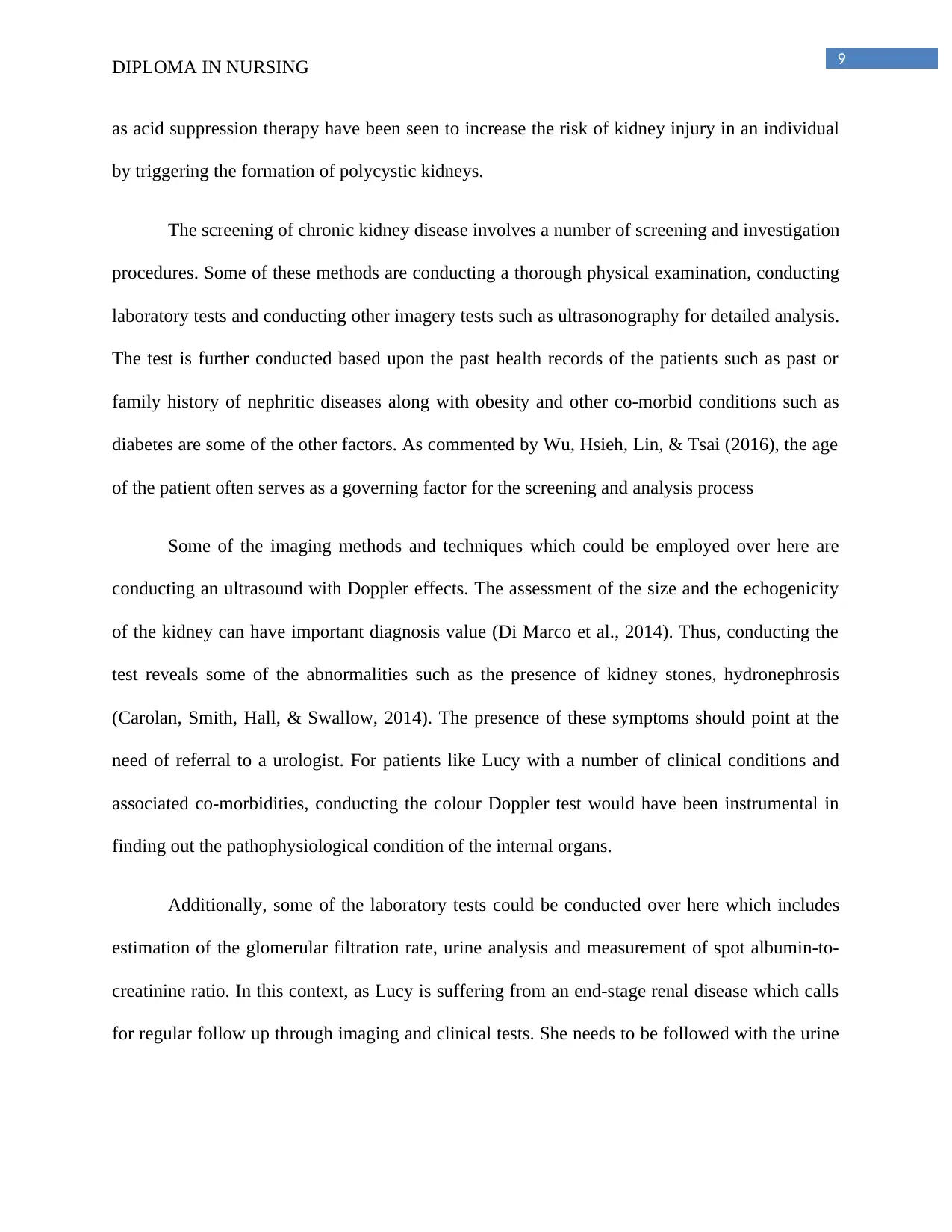
9DIPLOMA IN NURSING
as acid suppression therapy have been seen to increase the risk of kidney injury in an individual
by triggering the formation of polycystic kidneys.
The screening of chronic kidney disease involves a number of screening and investigation
procedures. Some of these methods are conducting a thorough physical examination, conducting
laboratory tests and conducting other imagery tests such as ultrasonography for detailed analysis.
The test is further conducted based upon the past health records of the patients such as past or
family history of nephritic diseases along with obesity and other co-morbid conditions such as
diabetes are some of the other factors. As commented by Wu, Hsieh, Lin, & Tsai (2016), the age
of the patient often serves as a governing factor for the screening and analysis process
Some of the imaging methods and techniques which could be employed over here are
conducting an ultrasound with Doppler effects. The assessment of the size and the echogenicity
of the kidney can have important diagnosis value (Di Marco et al., 2014). Thus, conducting the
test reveals some of the abnormalities such as the presence of kidney stones, hydronephrosis
(Carolan, Smith, Hall, & Swallow, 2014). The presence of these symptoms should point at the
need of referral to a urologist. For patients like Lucy with a number of clinical conditions and
associated co-morbidities, conducting the colour Doppler test would have been instrumental in
finding out the pathophysiological condition of the internal organs.
Additionally, some of the laboratory tests could be conducted over here which includes
estimation of the glomerular filtration rate, urine analysis and measurement of spot albumin-to-
creatinine ratio. In this context, as Lucy is suffering from an end-stage renal disease which calls
for regular follow up through imaging and clinical tests. She needs to be followed with the urine
as acid suppression therapy have been seen to increase the risk of kidney injury in an individual
by triggering the formation of polycystic kidneys.
The screening of chronic kidney disease involves a number of screening and investigation
procedures. Some of these methods are conducting a thorough physical examination, conducting
laboratory tests and conducting other imagery tests such as ultrasonography for detailed analysis.
The test is further conducted based upon the past health records of the patients such as past or
family history of nephritic diseases along with obesity and other co-morbid conditions such as
diabetes are some of the other factors. As commented by Wu, Hsieh, Lin, & Tsai (2016), the age
of the patient often serves as a governing factor for the screening and analysis process
Some of the imaging methods and techniques which could be employed over here are
conducting an ultrasound with Doppler effects. The assessment of the size and the echogenicity
of the kidney can have important diagnosis value (Di Marco et al., 2014). Thus, conducting the
test reveals some of the abnormalities such as the presence of kidney stones, hydronephrosis
(Carolan, Smith, Hall, & Swallow, 2014). The presence of these symptoms should point at the
need of referral to a urologist. For patients like Lucy with a number of clinical conditions and
associated co-morbidities, conducting the colour Doppler test would have been instrumental in
finding out the pathophysiological condition of the internal organs.
Additionally, some of the laboratory tests could be conducted over here which includes
estimation of the glomerular filtration rate, urine analysis and measurement of spot albumin-to-
creatinine ratio. In this context, as Lucy is suffering from an end-stage renal disease which calls
for regular follow up through imaging and clinical tests. She needs to be followed with the urine
Paraphrase This Document
Need a fresh take? Get an instant paraphrase of this document with our AI Paraphraser
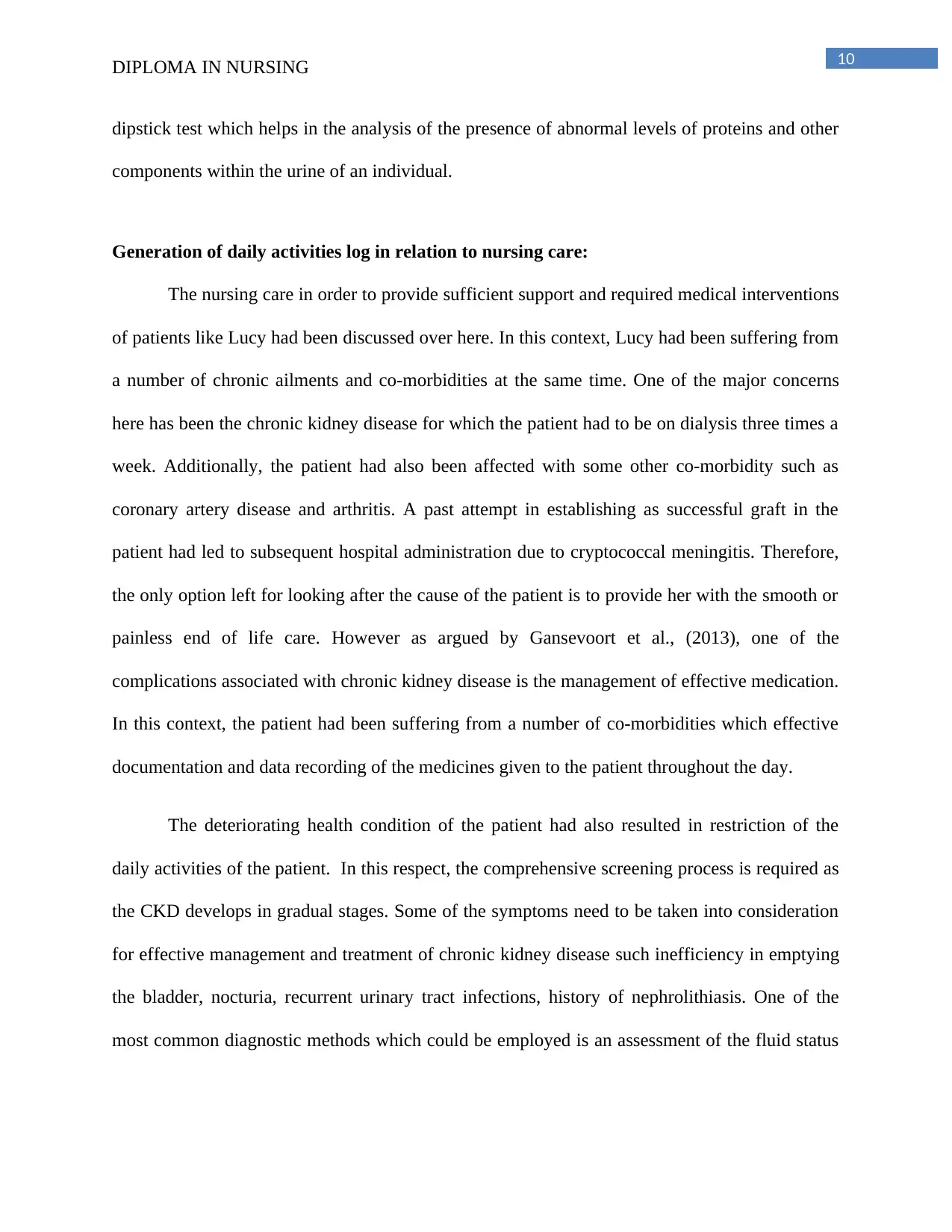
10DIPLOMA IN NURSING
dipstick test which helps in the analysis of the presence of abnormal levels of proteins and other
components within the urine of an individual.
Generation of daily activities log in relation to nursing care:
The nursing care in order to provide sufficient support and required medical interventions
of patients like Lucy had been discussed over here. In this context, Lucy had been suffering from
a number of chronic ailments and co-morbidities at the same time. One of the major concerns
here has been the chronic kidney disease for which the patient had to be on dialysis three times a
week. Additionally, the patient had also been affected with some other co-morbidity such as
coronary artery disease and arthritis. A past attempt in establishing as successful graft in the
patient had led to subsequent hospital administration due to cryptococcal meningitis. Therefore,
the only option left for looking after the cause of the patient is to provide her with the smooth or
painless end of life care. However as argued by Gansevoort et al., (2013), one of the
complications associated with chronic kidney disease is the management of effective medication.
In this context, the patient had been suffering from a number of co-morbidities which effective
documentation and data recording of the medicines given to the patient throughout the day.
The deteriorating health condition of the patient had also resulted in restriction of the
daily activities of the patient. In this respect, the comprehensive screening process is required as
the CKD develops in gradual stages. Some of the symptoms need to be taken into consideration
for effective management and treatment of chronic kidney disease such inefficiency in emptying
the bladder, nocturia, recurrent urinary tract infections, history of nephrolithiasis. One of the
most common diagnostic methods which could be employed is an assessment of the fluid status
dipstick test which helps in the analysis of the presence of abnormal levels of proteins and other
components within the urine of an individual.
Generation of daily activities log in relation to nursing care:
The nursing care in order to provide sufficient support and required medical interventions
of patients like Lucy had been discussed over here. In this context, Lucy had been suffering from
a number of chronic ailments and co-morbidities at the same time. One of the major concerns
here has been the chronic kidney disease for which the patient had to be on dialysis three times a
week. Additionally, the patient had also been affected with some other co-morbidity such as
coronary artery disease and arthritis. A past attempt in establishing as successful graft in the
patient had led to subsequent hospital administration due to cryptococcal meningitis. Therefore,
the only option left for looking after the cause of the patient is to provide her with the smooth or
painless end of life care. However as argued by Gansevoort et al., (2013), one of the
complications associated with chronic kidney disease is the management of effective medication.
In this context, the patient had been suffering from a number of co-morbidities which effective
documentation and data recording of the medicines given to the patient throughout the day.
The deteriorating health condition of the patient had also resulted in restriction of the
daily activities of the patient. In this respect, the comprehensive screening process is required as
the CKD develops in gradual stages. Some of the symptoms need to be taken into consideration
for effective management and treatment of chronic kidney disease such inefficiency in emptying
the bladder, nocturia, recurrent urinary tract infections, history of nephrolithiasis. One of the
most common diagnostic methods which could be employed is an assessment of the fluid status
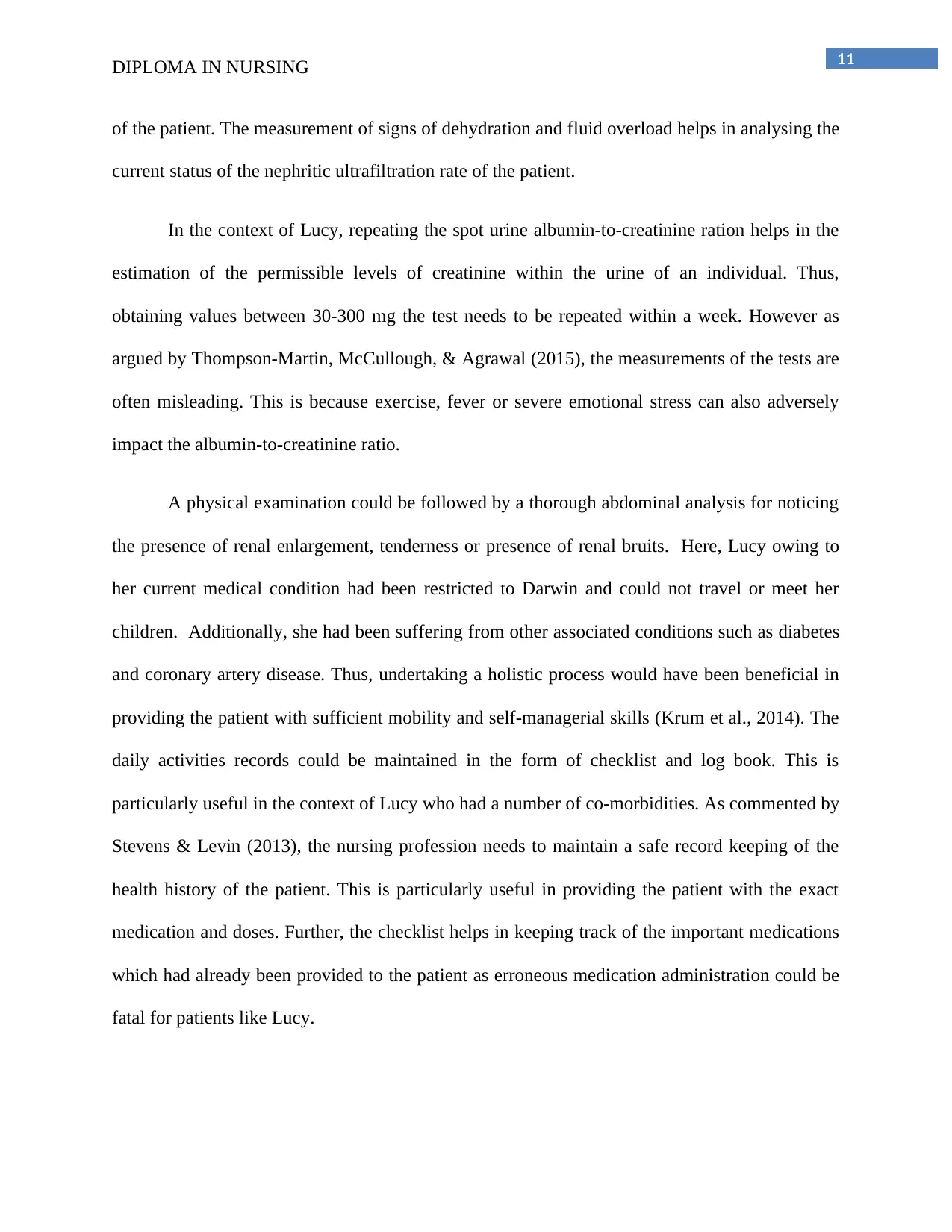
11DIPLOMA IN NURSING
of the patient. The measurement of signs of dehydration and fluid overload helps in analysing the
current status of the nephritic ultrafiltration rate of the patient.
In the context of Lucy, repeating the spot urine albumin-to-creatinine ration helps in the
estimation of the permissible levels of creatinine within the urine of an individual. Thus,
obtaining values between 30-300 mg the test needs to be repeated within a week. However as
argued by Thompson-Martin, McCullough, & Agrawal (2015), the measurements of the tests are
often misleading. This is because exercise, fever or severe emotional stress can also adversely
impact the albumin-to-creatinine ratio.
A physical examination could be followed by a thorough abdominal analysis for noticing
the presence of renal enlargement, tenderness or presence of renal bruits. Here, Lucy owing to
her current medical condition had been restricted to Darwin and could not travel or meet her
children. Additionally, she had been suffering from other associated conditions such as diabetes
and coronary artery disease. Thus, undertaking a holistic process would have been beneficial in
providing the patient with sufficient mobility and self-managerial skills (Krum et al., 2014). The
daily activities records could be maintained in the form of checklist and log book. This is
particularly useful in the context of Lucy who had a number of co-morbidities. As commented by
Stevens & Levin (2013), the nursing profession needs to maintain a safe record keeping of the
health history of the patient. This is particularly useful in providing the patient with the exact
medication and doses. Further, the checklist helps in keeping track of the important medications
which had already been provided to the patient as erroneous medication administration could be
fatal for patients like Lucy.
of the patient. The measurement of signs of dehydration and fluid overload helps in analysing the
current status of the nephritic ultrafiltration rate of the patient.
In the context of Lucy, repeating the spot urine albumin-to-creatinine ration helps in the
estimation of the permissible levels of creatinine within the urine of an individual. Thus,
obtaining values between 30-300 mg the test needs to be repeated within a week. However as
argued by Thompson-Martin, McCullough, & Agrawal (2015), the measurements of the tests are
often misleading. This is because exercise, fever or severe emotional stress can also adversely
impact the albumin-to-creatinine ratio.
A physical examination could be followed by a thorough abdominal analysis for noticing
the presence of renal enlargement, tenderness or presence of renal bruits. Here, Lucy owing to
her current medical condition had been restricted to Darwin and could not travel or meet her
children. Additionally, she had been suffering from other associated conditions such as diabetes
and coronary artery disease. Thus, undertaking a holistic process would have been beneficial in
providing the patient with sufficient mobility and self-managerial skills (Krum et al., 2014). The
daily activities records could be maintained in the form of checklist and log book. This is
particularly useful in the context of Lucy who had a number of co-morbidities. As commented by
Stevens & Levin (2013), the nursing profession needs to maintain a safe record keeping of the
health history of the patient. This is particularly useful in providing the patient with the exact
medication and doses. Further, the checklist helps in keeping track of the important medications
which had already been provided to the patient as erroneous medication administration could be
fatal for patients like Lucy.
⊘ This is a preview!⊘
Do you want full access?
Subscribe today to unlock all pages.

Trusted by 1+ million students worldwide
1 out of 23
Related Documents
Your All-in-One AI-Powered Toolkit for Academic Success.
+13062052269
info@desklib.com
Available 24*7 on WhatsApp / Email
![[object Object]](/_next/static/media/star-bottom.7253800d.svg)
Unlock your academic potential
Copyright © 2020–2025 A2Z Services. All Rights Reserved. Developed and managed by ZUCOL.





